The Intel Core i7-7700K (91W) Review: The New Out-of-the-box Performance Champion
by Ian Cutress on January 3, 2017 12:02 PM EST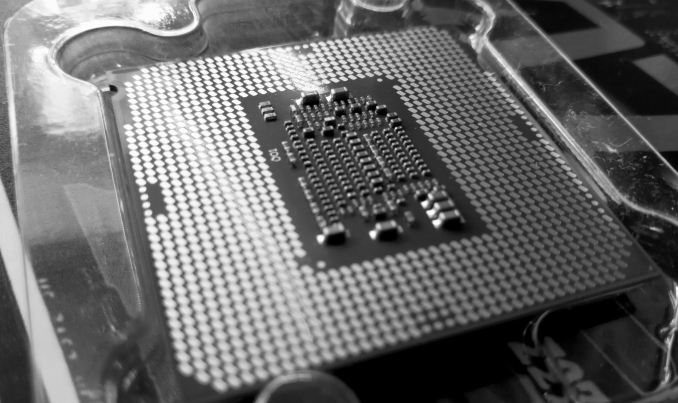
The i7-7700K, launched today, is Intel's fastest ever consumer grade processor. Using Intel’s third set of processors at 14nm, using the new 14+ variant, we get processors with a better frequency / voltage curve that translates into more performance, better efficiency, and the potential to push the silicon further and harder. Here is our review.
Meet Kaby Lake, and 4.5 GHz Out-of-the-Box
The i7-7700K is part of Intel's 7th Generation of Core CPUs, which often goes by its internal code name 'Kaby Lake'. The Kaby Lake family, as of today's launch, stretches from 91W on the mainstream desktop down to 4.5W for notebook processors, all using the same underlying technology in different core and integrated graphics configurations. The i7-7700K is the top part of this processor family, featuring four cores with hyperthreading, a 4.2 GHz base frequency, a 4.5 GHz turbo frequency, a couple of new tricks and all for $303 list (so about $330 retail).
As a processor with the letter K in it, in Intel's lingo this means the i7-7700K is an unlocked processor. Users with enough nous to understand the relationship between frequency, voltage, temperature and stability can take this processor above (or below) its standard operating frequency to get more performance without spending more money. The upshot of pushing the processor in this way is usually a higher power consumption, something that PC enthusiasts usually have to spare, and in the wrong hands a broken CPU through overclocking is worth the same as sand. There are two other K processors in the Kaby Lake family, the i5-7600K and the i3-7350K, which both have separate reviews as part of our launch coverage.
| Intel Kaby Lake S SKUs | |||||||
| Cores/ Threads |
Base/ Turbo |
IGP | L3 | eDRAM | TDP | Cost | |
| i7-7700K | 4/8 | 4.2/4.5 | HD 630 | 8 MB | - | 91 W | $305 |
| i7-7700 | 4/8 | 3.6/4.2 | HD 630 | 8 MB | - | 65 W | $272 |
| i7-7700T | 4/8 | 2.9/3.8 | HD 630 | 8 MB | - | 35 W | $272 |
| i5-7600K | 4/4 | 3.8/4.2 | HD 630 | 6 MB | - | 91 W | $217 |
| i5-7600 | 4/4 | 3.5/4.1 | HD 630 | 6 MB | - | 65 W | $199 |
| i5-7600T | 4/4 | 2.8/3.7 | HD 630 | 6 MB | - | 35 W | $199 |
| i5-7500 | 4/4 | 3.4/3.8 | HD 630 | 6 MB | - | 65 W | $179 |
| i5-7500T | 4/4 | 2.7/3.3 | HD 630 | 6 MB | - | 35 W | $179 |
| i5-7400 | 4/4 | 3.0/3.5 | HD 630 | 6 MB | - | 65 W | $170 |
| i5-7400T | 4/4 | 2.4/3.0 | HD 630 | 6 MB | - | 35 W | $170 |
| i3-7350K | 2/4 | 4.2 | HD 630 | 4 MB | - | 60 W | $157 |
| i3-7320 | 2/4 | 4.1 | HD 630 | 4 MB | - | 51 W | $139 |
| i3-7300 | 2/4 | 4.0 | HD 630 | 4 MB | - | 51 W | $129 |
| i3-7300T | 2/4 | 3.5 | HD 630 | 4 MB | - | 35 W | $129 |
| i3-7100 | 2/4 | 3.9 | HD 630 | 3 MB | - | 51 W | $109 |
| i3-7100T | 2/4 | 3.4 | HD 630 | 3 MB | - | 35 W | $109 |
Intel calls the desktop like of processors the S series, and Kaby Lake-S (or KBL-S) ranges from a dual core low power 35W i3-7100T to the high-end 91W i7-7700K. The idea here is to offer many different parts at different price points to cater for customer needs, such as performance, power, cost and feature set. With every launch Intel tries to entice users to upgrade from their older system (citing hundreds of millions of daily PCs being 3+ years old), and so having new features is key to having better performance too.
With the high-end i7-7700K, being the top processor, the main draw is typically performance and overclockability. This review aims to take us through both of these, and the reasons why.
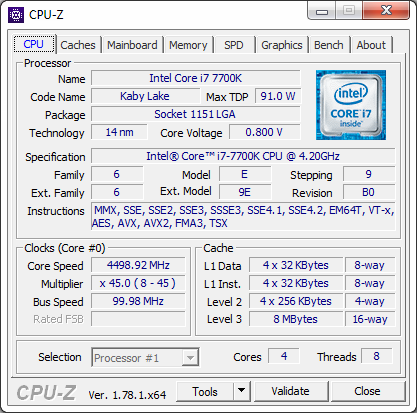
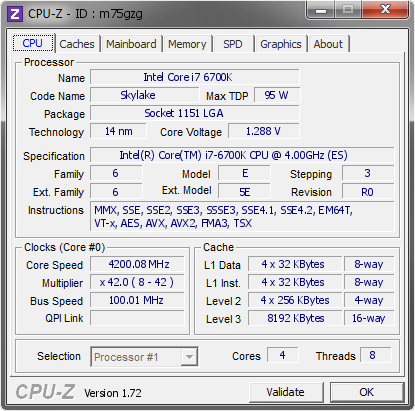
Intel Core i7-7700K (Kaby Lake) and Core i7-6700K (Skylake)
Comparing it to the previous generation high-end i7-6700K Skylake processor, we get the same configuration of cache hierarchy. The main difference between the two will be support for DDR4-2400 on the Kaby Lake rather than DDR4-2133, updated integrated graphics, a new generation of Speed Shift, AVX Offset support, and support for Intel’s ‘Optane Memory’.
Typically with each new generation of Intel CPUs brings about a fundamental increase in performance through the rate of instructions per cycle/clock (IPC) that the processor can go through. That being said, Intel has stated (and we've confirmed through testing) that Skylake and Kaby Lake are identical for IPC. As a result, the i7-7700K attempts to take the performance crown through frequency alone. The i7-6700K runs as 4.0 GHz base and 4.2 GHz turbo, while the i7-7700K runs at 4.2 GHz base and 4.5 GHz turbo. We quantify what this means in this review.
Speed Shift v2
For the i7-6700K family, Skylake, Intel introduced Speed Shift (v1). This was a feature that, at a high level, gave control of the voltage/frequency curve from the operating system to the processor. Using a series of internal metrics, such as instruction analysis and frequency, the CPU would automatically adjust the voltage and frequency of the processor as required. This afforded two major benefits: one, with the CPU in control it has access to many more points on the curve compared to the OS which is limited to specific P-states on the processor.
The second benefit is the speed of transition. A processor that can ramp up to a high frequency quickly and then drop down as needed can get through instructions quicker but also save power. Imagine driving a car, and having to wait 60 seconds to change a gear – it’s that sort of analogy.
What Speed Shift v2 does in the i7-7700K and the Kaby Lake family, compared to v1 in Skylake, is manage those transitions to higher frequency faster. Before Speed Shift, transitions from idle to peak turbo were on the order of 100 milliseconds, and Speed Shift v1 took that to 30 milliseconds (with a good base established within 15). Speed Shift v2 means that peak performance from idle now happens in 10-15 milliseconds total. This means that interactions with the OS, such as touch, or actions that rely on low latency, can occur within a couple of frames on a 60 Hz display.
The benefit of Speed Shift lies a lot in touch devices, which perhaps doesn’t affect the i7-7700K in this review, but also in web interactions. A lot of web work is stop and start, such as scrolling or javascript functions.
There is one caveat however – Speed Shift currently only works in Windows 10. It requires a driver which is automatically in the OS (v2 doesn’t need a new driver, it’s more a hardware update), but this limitation does mean that Linux and macOS do not benefit from it. I would be hard pressed to not imagine that Apple and Intel were not working on a macOS driver, but as yet we have not had confirmation that one exists.
Optane Memory Support
The latest memory technology to hit prime time is Intel and Micron’s 3D XPoint. This is a non-volatile form of data storage that is bit addressable and can be used as DRAM or storage. Despite being at least a decade in the making, and being formally announced in 2014, it is still yet to show up commercially as it is still being developed. Intel plans to create 3D XPoint DRAM that is slightly slower than normal DRAM but both denser (more of it) and non-volatile (keeps the data after power loss, saves power altogether), as well as 3D XPoint Storage that is faster than standard NAND flash, and more configurable. It the scheme of things, we expect the storage based products to hit the market first.
Intel, as far as we can tell, is set to release two main classes of product: Optane DRAM to be pin-compatible with DDR4 and require Optane DRAM enabled processors, and Optane SSDs which should work with any PCIe storage interface. ‘Optane Memory’ however, is something a little different. Based on pre-briefings, Optane Memory is certainly not Optane SSD we were told, but rather a storage cache for mechanical hard-drives. We’ve had this before with NAND flash drives, using Intel’s Rapid Storage Technology, and it seems that Kaby Lake and 200-series chipsets will support a new version of RST for PCIe-based storage. But because this is caching drive, such as the 16GB Optane Memory drives in Lenovo’s upcoming notebooks, and not Optane SSD, might lead us to believe that ‘Optane Memory’ drives are not designed to be directly user addressable.
All that being said, Intel has stated that Optane Memory standalone drives should hit the market nearer Q3 for general consumer use, which is more in-line with what we might expect to see with Optane SSDs in the enterprise space.
More about Kaby Lake
For readers that want a more in-depth take on Kaby Lake as a platform, we have a dedicated article full of information for you. We also have other articles in our Kaby Lake bonanza for launch day.
Other articles include:
Intel Launches 7th Generation Kaby Lake (Overview and Core Improvements)
The Intel Core i7-7700K Review: The New Out-of-the-box Performance Champion
The Intel Core i5-7600K Review: The More Amenable Mainstream Performer
The Intel Core i3-7350K Review: When a Core i3 Nearly Matches the Core i7-2600K
Upcoming (we’re at CES and didn’t have time to finish these yet):
Calculating Generational IPC Changes from Sandy Bridge to Kaby Lake
Intel Core i7-7700K, i5-7600K and i3-7350K Overclocking: Hitting 5.0 GHz on AIR
Intel Launches 200-Series Chipset Breakdown: Z270, H270, B250, Q250, C232
Intel Z270 Motherboard Preview: A Quick Look at 80+ Motherboards




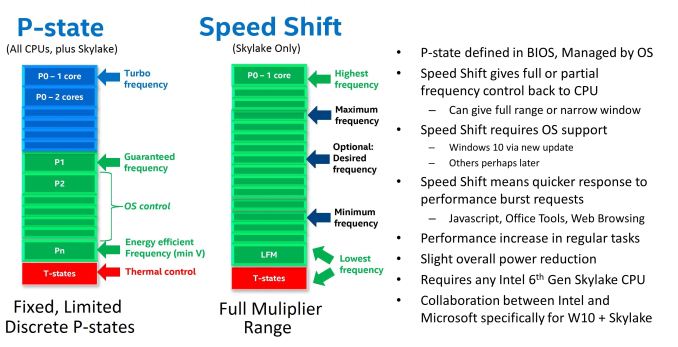
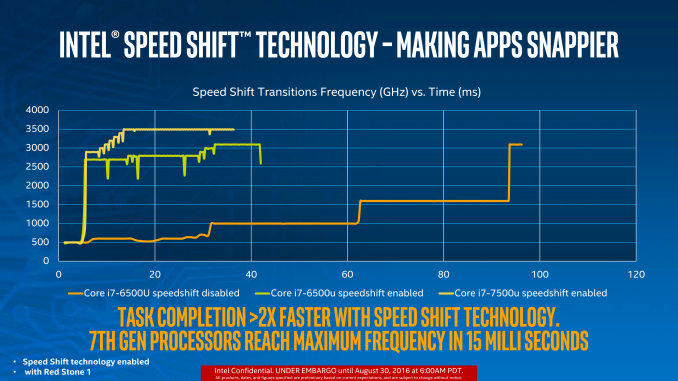









125 Comments
View All Comments
ThomasS31 - Tuesday, January 3, 2017 - link
I meant difference in high end CPUs... ofc. Sorry.Why no edit on your site? :)
pxnx - Tuesday, January 3, 2017 - link
These games are ancient, why even bother benchmarking them?Michael Bay - Saturday, January 14, 2017 - link
>2015>ancient
Mithan - Tuesday, January 3, 2017 - link
I have a 2500k, and I am going to upgrade (its 6 years old).Seriously considering a i7 7700k, people keep telling me to go for Zen because I am going to see a "big difference with games", even though those same people know that Zen will run slower on a per core basis.
I don't see this "big difference" with extra cores in todays games.
We can extrapolate based on current benchmarks, that the i7 7700k will be faster for games, as seen by using the 68xx Intel Series to compare against, even in Ashes of the Singularity.
I can see a "big difference" going from Core i5 to Core i7 or Core i5 to 6/8 Cores, but I don't see a big difference going from Core i7 to 6 or 8 cores in GAMES.
I get that unzipping documents, handbreak, etc are all going to be faster, but I don't particularly care about all those apps I rarely use (if I use them). It isn't like a 7700k is going to choke on Chrome.
I get that a 6 or 8 core will let me play a game and stream content faster (I don't stream).
Can somebody else sound in on my opinion?
DigitalFreak - Tuesday, January 3, 2017 - link
From what's known about Zen so far, you are correct. If all you care about is standard PC stuff and gaming, you're better off with a Kabey Lake i5 or i7. It looks like Zen will be cheaper but similar performing alternative to the Broadwell E processors for those that do more "workstation class" stuff. Of course that remains to be seen until we get some real unbiased benchmarks.close - Wednesday, January 4, 2017 - link
Until we see some retail parts it's hard to get an good idea about Zen. Clocks may vary from ES chips and the price might be motivating enough. 5-10% less performance for 40% lower price could be appealing to anybody who's not looking only at the very highest end of every component.close - Wednesday, January 4, 2017 - link
Also if you plan on holding onto this new CPU for a long time then go for more cores even if it comes with slightly lower clocks. You'll very likely be able to overclock it and squeeze more MHz but you'll never squeeze in more cores. And remember that 6-7 years ago dual-cores were considered the norm while today some games won't even start on a dual core.Game performance is getting less and less dependent on CPU so personally I would always go for the CPU that offers better general performance and more cores than one with slightly higher clocks that focuses the performance in games and gaming benchmarks. If you want better game performance think of a better GPU, that will actually bring palpable improvement over generations.
I'd hold on to the old 2500k for a while, until we get some nice reviews for what's coming.
carticket - Wednesday, January 4, 2017 - link
Just popping in (and registering) to echo that the 2500k is still a great CPU and this is not a great time to hop on the upgrade train with such an incremental upgrade over Skylake.I had a memory failure in my system, and that got me seriously considering a Kaby Lake upgrade, but for what would likely be a $500-600 upgrade, I just don't see a significant benefit. I say this as someone who hopped on the 970 train (upgrade from a 560 Ti) a few months before the 1070s hit the market with vastly better performance.
Toss3 - Wednesday, January 4, 2017 - link
The 7700K is going to be a massive upgrade and definitely worth it if you are currently on something older than Haswell. If your software/games are running at a decent framerate, and you really don't need to upgrade, then I'd suggest waiting as we'll start seeing 6 cores becoming the standard pretty soon (first with Zen and then with Coffee Lake).close - Wednesday, January 4, 2017 - link
Aren't we talking about the exact same massive upgrade a 6700K would have provided a year ago? If that wasn't enough to convince a user to upgrade then why would it be now?Upgrading now means they've just waited one more year with a really old CPU but ended up paying the same price for the same performance this year.
And thinking about an upgrade and those massive benefits just before we finally have a hope that AMD might launch something competitive isn't the best strategy even if your framerates already suffer. For the first time in years Intel might be forced to drop prices but why wait a couple of months when you can pay full price now for last year's CPU, right?